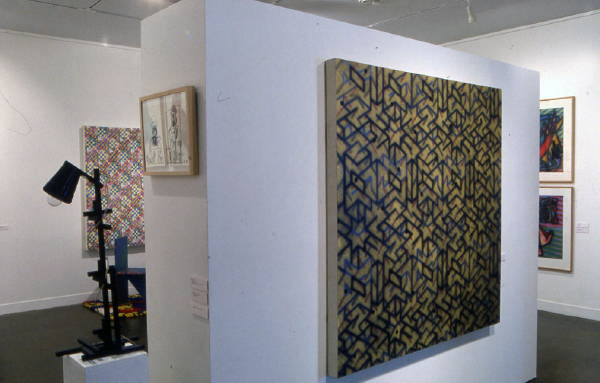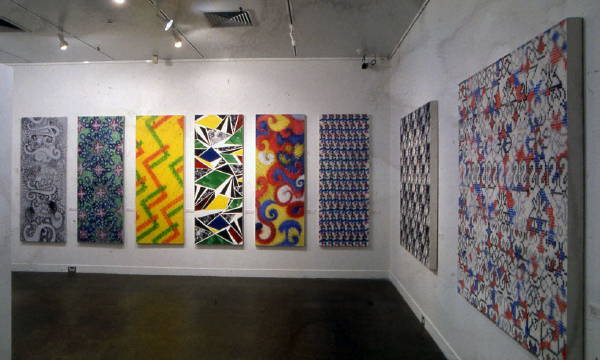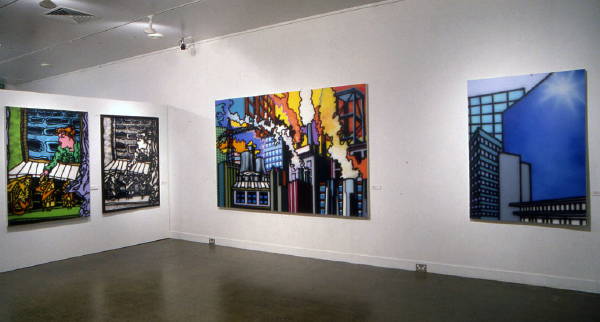‘HA: Howard Arkley’, Monash University Gallery, 18 Oct.-30 Nov.1991




[Installation photo showing (from left) cat.nos. 63, 43, 80 and 57 (source: Monash Visual Arts slide library)]
The Monash University Gallery, which had recently transferred from its original smaller premises in the Department of Visual Arts, into a purpose-built space in a new building designed by Melbourne architect Daryl Jackson, had been punching well above its weight for some time under director Jenepher Duncan, with an ambitious exhibition program featuring a sequence of highly significant survey shows of major mid-career Australian artists, including Micky Allan, Robert Rooney and Jenny Watson.[1]
The Arkley exhibition was a remarkable survey of his career to date, from his early ‘Surrealist’ works on paper and early ‘abstract’ and ornamental canvases, to key examples of his still developing suburban theme. Over eighty works were included, many still in the artist’s own collection. Curatorial work was handled originally by assistant curator Merryn Gates, and then, from August 1991, by Jenepher Duncan, who also edited the catalogue. Arkley took close interest in every aspect of the exhibition, for which he made detailed notes in his visual diaries, including several ideas for the invitation and catalogue cover – eventually based on a variant of his trademark Zappo Head.
An associated public forum was held at ACCA (12 Nov.), chaired by Janine Burke – the speakers were Arkley, Carolyn Barnes (VCA), Juliana Engberg (RMIT) and Robert Nelson (Monash University) [flyer in Arkley’s files].
The catalogue is a valuable publication, including a detailed chronology and exhibition details, an evocative new essay by Tony Clark (discussing Arkley’s work as ‘Gothic’), and previously published essays by Paul Taylor and Virginia Trioli.
Reviews of the show explored various other issues: Robert Rooney, for example, emphasised the order and control underpinning the apparent ‘chaos’ of Arkley’s imagery. Most writers focussed on his suburban theme, a topic interrogated with particular subtlety by Tim Sowden (in Agenda no.22, March/April 1992) and Juliana Engberg (in Transition 36/37, 1991), both emphasising the contrast between Arkley’s approach to suburbia and that of earlier protagonists like John Brack and Robin Boyd.
Engberg’s thought-provoking analysis emphasised feminist and architectural issues, concluding with a fascinating summary:
‘Masks and houses occupy the same territory for Arkley. They are all symbolic of the mapping of identity, the triple-fronted, the two-faced, the made-up and the made-over, are part of his cosmetic construct of a world viewed from the other side of the fence. That side is both feminine and ‘other’ in true states of displacement and dislocation, which makes the struggle for the right mark and the controlled gesture, and the final recognition that the place and mark is here, all the more remarkable.’ (Engberg 1992: 170).
Given the detailed check-list and a good set of installation slides taken at the time for the Visual Arts slide library at Monash, there are relatively few problems of identification. However, Arkley’s habit of re-titling some of his earlier works produced some anomalies – in fact, this is probably the first occasion when the full complexity of this issue began to become fully apparent (see e.g. comments on cat. nos.11, 14, 17 and 55 below). Understandably enough, a few errors of detail also crept into the Monash catalogue, and several issues remain unresolved concerning a handful of the works shown (as noted below).
The installation photos also indicate that at least two works not included in the final check-list actually did appear in the show (see below, following nos. 19 and 56). Arkley’s files also contain a copy of an preliminary working list for the exhibition (with the provisional title ‘It’s in the can’), which is a valuable resource in its own right regarding many of Arkley’s works, whether included in this survey show or not (several did not make the cut, including a work on paper version of Suicide, described in the working list as ‘too problematic’).
Works shown were as follows (nos. as listed in catalogue check-list):
1. What it’s like to be captured by my friends (1972) [W/P]
2. Have you any glass friends (1972) [W/P]
3. Self contained (1972) [W/P]
6. Study for Actuality [Monash #1] (1974) [W/P] and Study for Actuality [Monash #2] (1974) [W/P] (the second work is unidentified)
8. 9 x studies for White Paintings 1974-76:
[#1] Untitled [Monash 8.1] 1975 [W/P]
[#2] Untitled [Monash 8.2] 1976 [W/P]
[#3] Untitled [Monash 8.3] (c.1974-76) [W/P]
[#4] Untitled [Monash 8.4] (c.1974-76) [W/P]
[#5] Untitled [Monash 8.5] (c.1974-76) [W/P]
[#6] Untitled [Monash 8.6] (c.1974-76) [W/P]
[#7] Untitled [Monash 8.7] 1976 [W/P]
[#8] Untitled [Monash 8.8] 1975 [W/P]
[#9] Untitled [‘The Orient’ variant] 1976) [W/P]
9. Actuality (the Void between Events) (1975) = (presumably) Actuality (Is the Void Between Events) 1976
10. Recording (Scientific Knowledge) (1975): unidentified at this stage
11. Primal (Thought Form) 1976 = Organic Model (Intuitive Reason) (1976) (P/C Melb.): installation photos show that this was the work shown in HA Coventry 5/77 cat.8, as ‘Organic Model D (Intuitive Reason)’, and then later exhibited and reproduced under various different titles (see catalogue entry for details).
12. Inventory 1976: shown at Monash as in the artist’s collection
13. Organic Model G (Black Square) 1976 = Organic Model G (Black Square) [Tolarno] 1976: clearly identifiable via slides taken at the Monash exhibition; first shown in HA Tolarno 8/76 (cat.9) as ‘Primal (Thought Forms)’.
14. Curvilinear 1978 = Arabesque 1979 [Curvilinear] (Monash University collection); this work was first exhibited as ‘Curvilinear’ at Tolarno 5/79, cat.12 and HA Coventry 3/80, cat.70, and then, after 1988 (apart from the present exhibition), as ‘Arabesque’ (see catalogue entry for details).
15. Curvilinear with Grid 1978

[Installation shot showing (from left), cat.nos. 14, 16, 17, 19; Psychedelic (1978) (not in catalogue); and cat.nos. 20, 37 and 36 (source: Monash Visual Arts slide library: damaged slide)]
16. Floral = Arabesque 1979 [Floral] (P/C Melb.): exh.at Monash as inscribed on reverse: ‘Arabesque/H Arkley/79’; 1st exh. HA Coventry 3/80 as ‘Arabesque’ (cat.11); reproduced in Spray 30 as ‘Floral’ and also shown with that title in the Arkley retrospective 2006-7.
17. ‘Bodgie No.2 1979’ = Bodgie 1979 (P/C Melb.): exh.at Monash as inscribed on reverse: ‘Howard Arkley/Bodgie/1979’; 1st exh.HA Tolarno 5/79 as ‘Deco’ (cat.13), then HA Coventry 3/80 as ‘Bodgie-Widgie’ (cat.5); reproduced in Spray 28 as ‘Bodgie/Widgie’ and in Carnival Fig.2.3 as Bodgie [aka Deco, Bodgie-Widgie] 1979.
18. Deco 1979 (as coll.MCA Brisbane, inscribed on reverse ‘Deco/1979/H Arkley’) = Deco 1979 [aka Arrows-Crosses].
19. ’50s 1979 (as coll.MCA Brisbane, inscribed on reverse ‘50’s H Arkley 79’) = 50’s 1979.
— Psychedelic 1979: NB while not included in the catalogue check-list, this work was clearly in the Monash show, as the installation photo reproduced above demonstrates; the picture was also included in the working list for the show.
20. Arrows and Crosses 1980: (P/C Melb.): 1st exh.HA Coventry 3/80 as ‘Ticks and Crosses’ (cat.13); reproduced in Burke 1981: 364 as ‘Op’, and in S.28 with the incorrect title ‘Deco’ (resulting from confusion between this work and Deco 1979 [aka Arrows-Crosses] [cat.18 above])
21. Chair (1980) [3/M]
22. Isometric Chair (1980): work on paper previously listed in the present catalogue as unidentified, but now identified as probably identical with W Chair (1980) [W/P] (NB the work reproduced as ‘Isometric Chair, 1980’ in S.54 is actually one of the Four Chairs W,V,X,T 1980 [W/P] also included, separately, in the Monash 1991 exhibition: see cat.no.30 below)
23. Lattices 1980 (as coll.Sir James & Lady Cruthers, inscribed ‘Howard Arkley/1980/Lattices’) = Lattice and Grids 1980, 1st exh.HA Tolarno 7/81, cat.no.4 (as ‘Lattice and Grids’).
24. Printout II (red and blue) 1980 (as P/C, 90.5 x 122, inscribed: ‘Printout II/H ARKLEY 80’): presumably = Printout Red/Blue 1980
25. Room Interior 1980 [W/P] (NGA, Canberra; from ‘Functional Objects’ series)
26. Tram Drawing 1980 (as coll. NGA) = Drawing for Decorated Tram Project 1980 [W/P]
27. Study for Red Wedge carpet 1980 (as inscribed ‘Red Wedge, Howard Arkley ’81) = Red Wedge [#2] 1981 [W/P] (NB not, as previously indicated in this catalogue, Red Wedge [#1] 1981 [W/P], the similar work first shown at both Tolarno and Solander in 1981). This work was lent by the same owner as Discocacti [study] (1986?) [W/P].
29. Red Dress (1980-81) [W/P] = Dress 1980 [W/P]
30. W,V,X,T (Four Chairs) 1980 = Four Chairs W, V, X, T 1980 [W/P]
31. Table Lamp (1980-81) [3/M]
32. Logitex (table and chair tableau) (1980-84) [3/M]
33. Icon 1981 (Artbank, Sydney, and inscribed: ‘Howard Arkley 83’) = Icon (triptych) 1983 (Artbank coll.); the date of 1981 given in the Monash catalogue is clearly a typo
34. Metallic 1981 (AGWA, Perth)
35. Ornamentic 1981 (AGWA, Perth)
36. Printout 1981 (Artbank, Sydney)
38. Vortex 1981 (P/C Brisbane)
39. Primitive (Gold) 1982 (NGV, Melbourne)
40. Primitive Silver 1982 (P/C Melb.)
41. ‘Selection of artist’s inflatable toy collection 1982’ (9 Polaroid photos): see comments and photo under 1982
42. Cartographer (After Durer) 1983 (P/C Perth?)

[Installation shot showing (from left) cat..nos. 32/52 (background), 31, 54 (left foreground), 34; uncatalogued work-on-paper variant of Discocacti (1986); and cat.no. 74 (source: Monash Visual Arts slide library)]
43. Felony (1983) [W/P] (MCA coll., Sydney): exh.at Monash as courtesy of Tolarno
44. Model 1983: 1st exh.HA Roslyn Oxley9, 6/83 as ‘Model’ (cat.3), then in HA Tolarno 10/83 as ‘Zygocactus’ (cat.11), but again here as Model
46. Tattooed Head (1983): now TarraWarra Museum of Art; exh. at Monash as P/C
47. Tattooed Feet 1983
48. Tattooed Hands 1983
49. Tattooed Penis 1983 [W/P]: now
P/C Brisbane; exh.at Monash as coll.artist
50. Winds of War Graffiti 1983: 1st exh. HA Tolarno 10/83 as ‘Billboard’; later inscribed with its present title (shown thus at Monash, as coll.artist)
52. Logitex 1983 (NGA) = Logitec (1981?): see now cat.no.32 above
53. Doodles (Courage My Heart) 1984 (6 pages) – see under Mills & Boon books
54. Icons 1984 (2 works on paper) = Untitled [Icon #1] 1984 [W/P] and Untitled [Icon #2] 1984 [W/P]
55. Agave Parviflora 1985 (P/C Melb.): this is the monochrome work first shown at Tolarno 10/83 as Peel of the Orange (cat.10); for full details, see the relevant entry.
56. Discocacti 1986: shown at Monash as courtesy Martin Browne Fine Art; in the Budget collection from 1987, then auctioned with that collection, Sotheby’s Sept.1992.
— Discocacti [study] (1986?) [W/P]: not in the Monash catalogue check-list, but clearly included in the show: see installation shot reproduced above, and Monash gallery files, including the owner’s details. The same collector also lent Red Wedge [#2] 1981 [W/P] (cat.no.27).
57. High Rise St Kilda Road 1986
58. The Ritual 1986 (State Library of Victoria)
59. Studies for Houses and Homes 1986: 4 coloured photocopies, not certainly identified
60. Totems-Epiphyllum-Hybrid 1986
61. Ever feel like drowning 1987
62. Ever feel like drowning (1987) [W/P]
63. Felony 1987 [cf. cat.43 = 1983 work on paper]
65. Still Life Petunias 1987: shown at Monash as P/C; NB subsequently in BP collection, subsequently auctioned with that collection, Sotheby’s Melb., Sept.2002
66. Selection of source photographs for ‘Suburban House’ series 1987 [3/M]: 6 photos
67. Suburban Window 1987 = Suburban Window 1987 [Howard Arkley & Christine Johnson]: NB this is now recognised as a collaborative work (see now Carnival: 147, citing article by Litson 2001); exh.at Monash as courtesy Roslyn Oxley9
68. Tudor House 1987
69. Zappo Head (1987) [Bendigo]: exh. at Monash as P/C
70. Zappo Head 1985 [W/P]: shown at Monash as dating from 1987
71. Chair Tableau with Muzak Mural; and source material (1988 and earlier) [W/P] (NGV): both the work on paper and the source material (cat.72) were shown at Monash; cat.71 was the main work on paper
72. Source material panel for cat.no.71
73. House and Garden Western Suburbs, Melbourne 1988 p>
75. Triple Fronted 1987
76. Source material for the work-on-paper Tattooed Head in the NGV: see Tattooed Head; and source material (1988 and earlier) [W/P] (apparently the work on paper was not shown at Monash)
77. Corner House with Hedge 1989
80. Shadow Factories 1990 [Spray]: NB the Monash catalogue gives incorrect size of 75 x 274 (!) – actually 175 x 275; the working list for the Monash exhibition refers to the version of this theme owned by Corbett Lyon (see Shadow Factories 1990 [Lyon]), but installation photos (e.g. the example reproduced here) clearly show that the version reproduced in Spray 96-7 was the one finally included.
81. Four chairs (1981-1991) [3/M] (catalogued as artist’s coll.): only three chairs appear to have been exhibited (installation photo); the fourth may have been the unfinished example Untitled (Chair) (1991) [3/M], which surfaced at auction in 2009.
[1] Arkley’s library included the catalogues for all these shows, dating from 1987, 1990 and 1985 respectively.